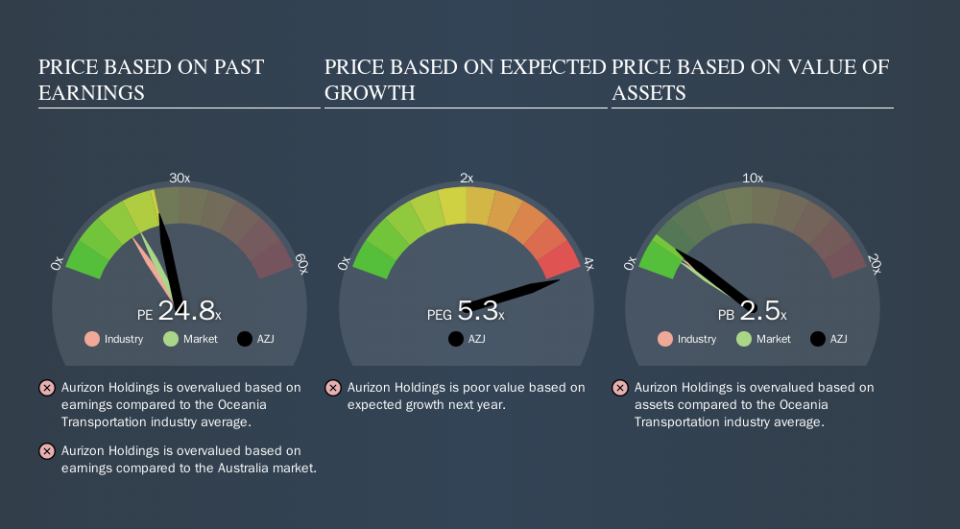Despite Its High P/E Ratio, Is Aurizon Holdings Limited (ASX:AZJ) Still Undervalued?

This article is written for those who want to get better at using price to earnings ratios (P/E ratios). We'll show how you can use Aurizon Holdings Limited's (ASX:AZJ) P/E ratio to inform your assessment of the investment opportunity. Aurizon Holdings has a price to earnings ratio of 24.81, based on the last twelve months. That corresponds to an earnings yield of approximately 4.0%.
View our latest analysis for Aurizon Holdings
How Do You Calculate Aurizon Holdings's P/E Ratio?
The formula for P/E is:
Price to Earnings Ratio = Share Price ÷ Earnings per Share (EPS)
Or for Aurizon Holdings:
P/E of 24.81 = A$5.90 ÷ A$0.24 (Based on the year to June 2019.)
Is A High Price-to-Earnings Ratio Good?
A higher P/E ratio means that investors are paying a higher price for each A$1 of company earnings. All else being equal, it's better to pay a low price -- but as Warren Buffett said, 'It's far better to buy a wonderful company at a fair price than a fair company at a wonderful price.
Does Aurizon Holdings Have A Relatively High Or Low P/E For Its Industry?
We can get an indication of market expectations by looking at the P/E ratio. You can see in the image below that the average P/E (15.6) for companies in the transportation industry is lower than Aurizon Holdings's P/E.
That means that the market expects Aurizon Holdings will outperform other companies in its industry. Clearly the market expects growth, but it isn't guaranteed. So investors should delve deeper. I like to check if company insiders have been buying or selling.
How Growth Rates Impact P/E Ratios
Earnings growth rates have a big influence on P/E ratios. Earnings growth means that in the future the 'E' will be higher. And in that case, the P/E ratio itself will drop rather quickly. And as that P/E ratio drops, the company will look cheap, unless its share price increases.
Aurizon Holdings saw earnings per share decrease by 15% last year. But it has grown its earnings per share by 15% per year over the last five years.
Remember: P/E Ratios Don't Consider The Balance Sheet
One drawback of using a P/E ratio is that it considers market capitalization, but not the balance sheet. In other words, it does not consider any debt or cash that the company may have on the balance sheet. The exact same company would hypothetically deserve a higher P/E ratio if it had a strong balance sheet, than if it had a weak one with lots of debt, because a cashed up company can spend on growth.
Spending on growth might be good or bad a few years later, but the point is that the P/E ratio does not account for the option (or lack thereof).
So What Does Aurizon Holdings's Balance Sheet Tell Us?
Aurizon Holdings has net debt equal to 29% of its market cap. While it's worth keeping this in mind, it isn't a worry.
The Bottom Line On Aurizon Holdings's P/E Ratio
Aurizon Holdings trades on a P/E ratio of 24.8, which is above its market average of 18.4. With modest debt but no EPS growth in the last year, it's fair to say the P/E implies some optimism about future earnings, from the market.
When the market is wrong about a stock, it gives savvy investors an opportunity. People often underestimate remarkable growth -- so investors can make money when fast growth is not fully appreciated. So this free report on the analyst consensus forecasts could help you make a master move on this stock.
But note: Aurizon Holdings may not be the best stock to buy. So take a peek at this free list of interesting companies with strong recent earnings growth (and a P/E ratio below 20).
We aim to bring you long-term focused research analysis driven by fundamental data. Note that our analysis may not factor in the latest price-sensitive company announcements or qualitative material.
If you spot an error that warrants correction, please contact the editor at editorial-team@simplywallst.com. This article by Simply Wall St is general in nature. It does not constitute a recommendation to buy or sell any stock, and does not take account of your objectives, or your financial situation. Simply Wall St has no position in the stocks mentioned. Thank you for reading.

 Yahoo Finance
Yahoo Finance 
